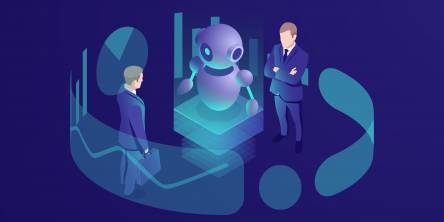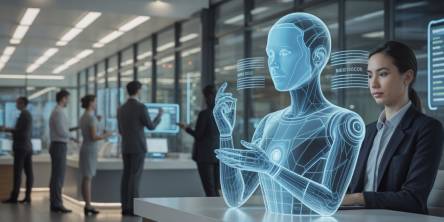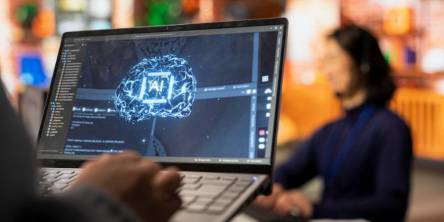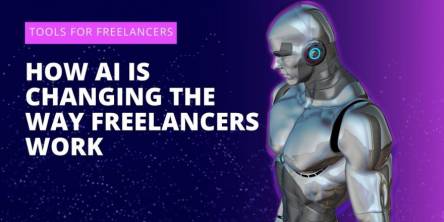How AI is Impacting Healthcare Tech

Think about a worried mom waiting to hear if the strange spot on her child’s skin is something to be concerned about. Or imagine an elderly grandfather hoping that recent tests will show he’s healthy. These are real people waiting for important answers about their health.
In medical labs across the country, pathologists are looking for the answers to these concerns by examining small samples of skin, blood, and other tissues through powerful microscopes. But now, they have a helpful new partner: a smart computer system called AI which can spot patterns and find answers faster.
But how exactly is it helping healthcare tech right now? Let’s take a look at some real examples of how these smart systems are working alongside medical professionals to help people get faster, more accurate answers about their health.
Read more: Top IT Challenges Healthcare Organizations Are Facing Today
Pattern Recognition
A doctor might see dozens of patients each day, making it hard to remember every detail from past visits. Think of AI as that assistant that never gets tired and can remember every single detail.
This ability makes a big difference in how medical labs handle test results. For instance, it can spot tiny changes that might be hard for humans to notice. It can remember and compare all previous tests and even find patterns across thousands of patient results.
Let’s say a patient has a tiny spot on their skin that’s slowly changing shape or color over months or years. AI can alert doctors about this pattern and catch potential health issues sooner while it’s still easy to treat.
Its ability to get a broader view of patient results also helps medical experts:
-
Understand how certain conditions might spread in a community
-
Identify which groups of people might need extra health screenings
-
Track whether new treatments are working wel
Automatic Quality Control
Every medical test needs to be accurate - after all, important health decisions depend on these results. AI helps labs keep their tests reliable and accurate in ways that weren’t possible before.
Instead of waiting for something to go obviously wrong (like a failed test), AI watches for early warning signs. It looks at thousands of past test results to understand what “normal” looks like. Then, it notices tiny changes that might affect test quality and warns lab staff before small issues become big problems.
For example, AI might notice that test results start becoming slightly less accurate at certain times of day or when certain equipment has been running for many hours. It can then alert lab staff to check the equipment or adjust their procedures - before any patient results are affected.
Without AI, labs typically check their quality through scheduled inspections. But with AI, you automatically get alerted if something needs attention. The result is more reliable lab tests, fewer errors, and, most importantly, patients can have more confidence in their test results.
Smarter Scheduling
Running a medical lab involves many moving parts that need to work together perfectly. AI is able to manage the daily work of these labs better by learning from past patterns and planning for the future.
It remembers things like how many samples usually arrive each day, which times of the year are busiest, and even which types of tests take longer to complete. AI uses this information to help labs schedule the right number of people to work at the right times. This means patients get their results on time, and lab staff aren’t overwhelmed during busy periods.
AI also helps decide the best order to run tests. It considers which tests are most urgent, which machines are available, and even when machines need maintenance breaks. This means expensive lab equipment gets used more efficiently, and staff members aren’t bogged down with scheduling matters.
Better Image Analysis
In labs that study skin samples and other tissues, AI makes studying these specimens faster and more thorough. While doctors are still the ones making final decisions about diagnosis, AI helps them work more efficiently by doing an initial review of tissue samples.
When a new tissue sample arrives, AI quickly looks at the whole image and marks areas that need a closer look. It measures important features in exactly the same way every time, which helps make test results more consistent between different patients and different labs.
As AI looks at each new sample, it compares it to millions of other samples it has seen before. This means it can spot tiny details that might be important for the patient’s health. A doctor might see hundreds or thousands of samples in their career, but AI can access information from millions of previous cases to help spot important patterns.
It doesn’t completely replace doctor expertise. It just gives them more tools and information to help them make better decisions for their patients.
Integrated Health Information
AI helps labs look at the bigger picture of someone’s health by connecting different pieces of information. Instead of looking at each test result by itself, AI can look at all of a patient’s health information at once.
When new test results come in, AI connects them with the patient’s previous test results and health history. Sometimes, a single test result might look normal on its own, but AI might notice that it’s very different from the patient’s usual results. This gives doctors a more complete understanding of what’s happening with their patient’s health. It’s especially helpful when test results are unexpected or when a patient has complicated health issues.
Real-World Challenges
Bringing AI into laboratory information systems isn’t simple. The first hurdle is cost - smaller labs operating on tight budgets may struggle to invest in advanced AI-enabled systems. While the long-term benefits are clear, the initial investment in both the software and compatible equipment can take up a huge chunk of the budget.
Another challenge is getting AI features to work with existing lab systems. Many labs already have established systems for their daily workflow, and it would take careful planning and technical expertise to make these older systems work with new AI tools.
Labs are also beginning to see the need for training their staff to work confidently with AI-enhanced systems. Lab technicians and pathologists need to understand not just which buttons to press but how to interpret AI suggestions and when to rely on their own expertise. This means developing new workflows that combine human experience with AI capabilities.
The Road Ahead
Despite these obstacles, AI in laboratory systems continues to advance. While smaller labs might need to wait longer before implementing full AI systems, even basic AI features can help improve their daily operations.
Each new development in AI technology brings us closer to a future where every lab, regardless of size, can access these powerful tools. When that happens, we won’t just be changing how labs work - we’ll be changing how quickly and accurately patients get answers about their health.
Similar Articles
The goal of AI is to enable businesses to operate more efficiently, develop better products, and support QA teams in completing their tasks more effectively.
Bring still images to life with make a photo talk AI tools. Learn how to create a natural AI talking avatar using Media.io's powerful audio-video models and templates.
AI agents are no longer an experiment in financial institutions. They are becoming the operational engine that powers real time decisioning, proactive fraud defense, precise risk scoring, and automated compliance workflows.
Banks are facing a moment of truth. Customer expectations are rising faster than most institutions can reshape their operating models.
How AI SDRs turn first contact into booked meetings with smart outreach strategies in this step-by-step journey breakdown.
How AI is transforming freelancing by boosting productivity, streamlining tasks, and reshaping the future of independent work.
AI chatbots are reshaping scam prevention with real-time detection, deepfake defense, and personalized protection against cybercriminals.
When I first started working in branding, creating a logo was a long and expensive process. Ordering from a designer required weeks of discussions and a budget that small businesses often couldn’t afford.
Generative AI is not just another addition to the toolbox of products; it will soon serve as the co-pilot for the entire lifecycle process, including discovery and delivery.









